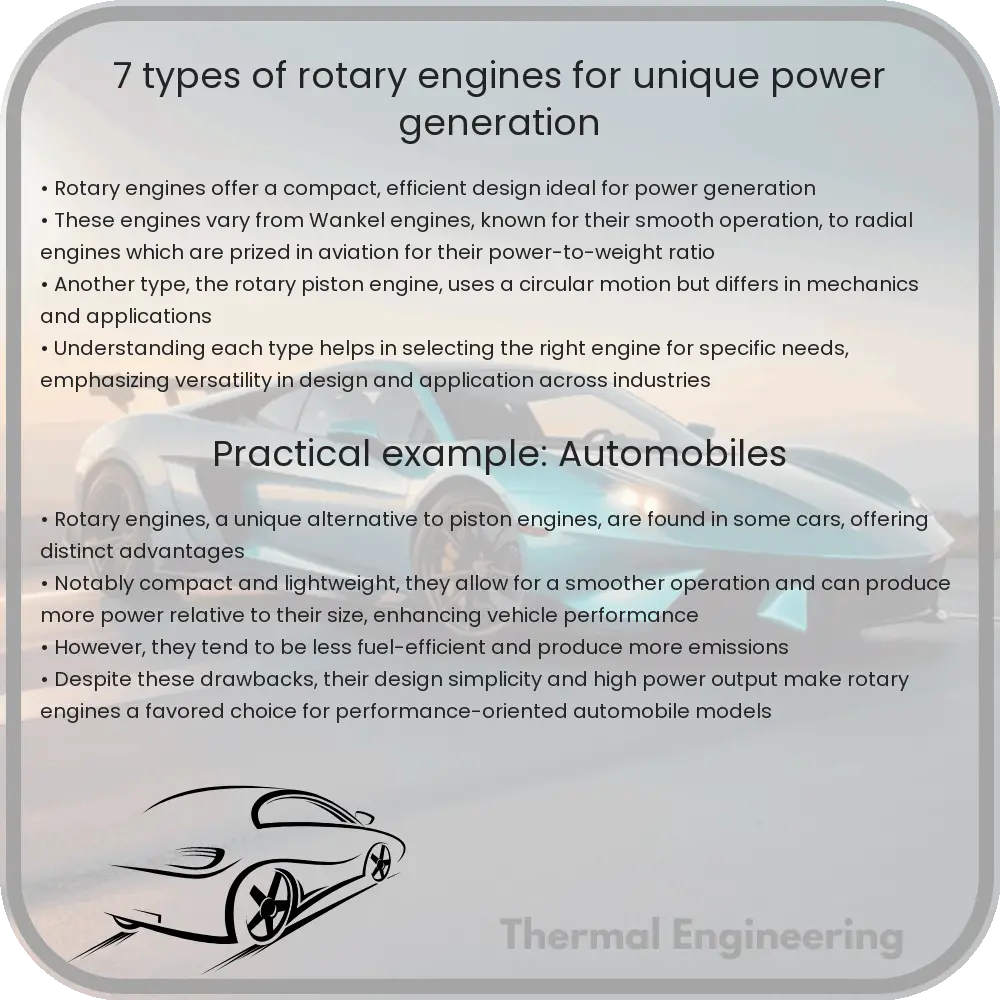Explore seven types of rotary engines, each with unique mechanisms and applications in industries like automotive and aerospace.

Understanding Rotary Engines: 7 Variants for Unique Power Generation
Rotary engines, known for their compact and efficient design, offer unique advantages and are utilized in various applications ranging from automobiles to aircraft. Unlike the traditional reciprocating piston engines, rotary engines employ a different mechanism for converting pressure into rotating motion. This article explores seven types of rotary engines, each with its particular characteristics and applications.
1. Wankel Engine
The Wankel rotary engine is perhaps the most renowned variant, notable for its use in Mazda vehicles like the RX-7 and RX-8. The engine features a triangular rotor that orbits in an epitrochoidal motion within an oval-like chamber. This design allows for smooth operation and fewer moving parts than conventional piston engines. Each side of the rotor covers a specific phase of the four-stroke cycle (intake, compression, combustion, and exhaust), making the engine compact and lightweight.
2. Gas Turbine Engine
Gas turbines are primarily used in aircraft, power plants, and marine applications. These engines operate on the Brayton cycle, drawing in air through a compressor, mixing it with fuel to burn in a combustion chamber, and expelling it through a turbine to produce thrust or mechanical power. Rotary motion is intrinsic to their operation, characterized by high power output and efficiency at high speeds.
3. Rotary Vane Engine
The rotary vane engine uses sliding vanes in a circular rotor, which rotates inside a larger housing. The housing can be circular, elliptical, or a more complex shape, depending on the design. This engine type is typically used in hydraulic pumps and pneumatic motors, where low torque and consistent power are required.
4. LiquidPiston Engine
This is a modern take on the rotary engine, designed to improve the efficiency, reduce the physical footprint, and minimize the vibration. The LiquidPiston engine incorporates a high-efficiency ‘X’ engine configuration that implements a thermodynamic cycle known as the High Efficiency Hybrid Cycle, combining features from Otto, Diesel, and Atkinson cycles. It’s aimed primarily at applications requiring lightweight, compact power sources.
5. Rotary Atkinson Cycle Engine
By applying the Atkinson cycle to a rotary mechanism, this engine variant achieves better fuel efficiency. The Atkinson cycle allows for a different compression and expansion volume, leading to greater thermal efficiency. This technology is particularly valuable in hybrid electric vehicles where efficiency is paramount. These engines maintain a rotary core but alter the way the internal volume changes during operation.
6. Quasiturbine
The Quasiturbine engine is characterized by a rotor housed within a shaped stator. The rotor’s blades slide, rotate, and rock, creating different pressure zones within the engine chamber that are used to produce power. Unlike the Wankel engine, it does not require an oval-like epitrochoidal housing, which results in less friction and higher efficiency. It is suitable for a broad range of fuels, including gasoline, diesel, and hydrogen.
7. Rand Cam Engine
Last in this list but not least innovative, the Rand Cam engine features a cam and follower system that generates direct rotational motion. This design eliminates the need for a dedicated crankshaft, enabling a smoother and more compact engine configuration. The engine is very versatile in the types of fuels it can utilize, ranging from conventional fuels to biofuels, positioning it well for various industrial applications.
Each of these rotary engines contributes uniquely to the landscape of power generation by offering different benefits, such as reduced size, lower emissions, high power density, or improved fuel efficiency. They underscore an essential aspect of engineering: innovation tailored to specific needs and applications, pushing the boundaries of what rotary mechanisms can achieve.